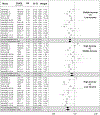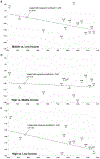Disparities in childhood overweight and obesity by income in the United States: an epidemiological examination using three nationally representative datasets
- PMID: 30718822
- PMCID: PMC11460982
- DOI: 10.1038/s41366-019-0331-2
Disparities in childhood overweight and obesity by income in the United States: an epidemiological examination using three nationally representative datasets
Abstract
Background/objectives: Overweight and obesity (OWOB) is a global epidemic. Adults and adolescents from low-income households are at higher risk to be OWOB. This study examined the relationship between income and OWOB prevalence in children and adolescents (518 years) in the United States (US) within and across race/ethnicities, and changes in this relationship from 1971 to 2014.
Subjects/methods: A meta-analysis of a nationally representative sample (N = 73,891) of US children and adolescents drawn from three datasets (i.e., National Health and Nutrition Examination Survey, National Longitudinal Survey of Youth, & the Early Childhood Longitudinal Program) which included 14 cross-sectional waves spanning 1971-2014 was conducted. The exposure was household income-to-poverty ratio (low income = 0.00-1.00, middle income = 1.01-4.00, high income >4.00) with prevalence of overweight or obesity (body mass index ≥ 85th percentile) as the outcome.
Results: Children and adolescents from middle-income and high-income households were 0.78 (95% CI = 0.72, 0.83) and 0.68 (95% CI = 0.59, 0.77) times as likely to be OWOB compared to children and adolescents in low-income households. Separate analyses restricted to each racial/ethnic group showed children and adolescents from middle- and high-income households were less likely to be OWOB compared to their low-income peers within the White, Hispanic, and Other race/ethnic groups. Children and adolescents from low-income households who were Black were not more likely to be OWOB than their high- and middle-income counterparts. Analyses within each income stratum indicated that race/ethnicity was not related to the prevalence of OWOB in low-income households. However, racial/ethnic differences in OWOB were evident for children and adolescents in middle- and high-income households. Disparities in the prevalence of OWOB between low-income children and adolescents and their middle- and high-income counterparts have increased from 1971 to 2014.
Conclusions: Income and OWOB are related in US children and adolescents. Racial/ethnic differences in the prevalence of OWOB emerge in middle- and high-income households. Disparities in OWOB prevalence are growing.
Conflict of interest statement
Figures




References
MeSH terms
Grants and funding
LinkOut - more resources
Full Text Sources
Medical

